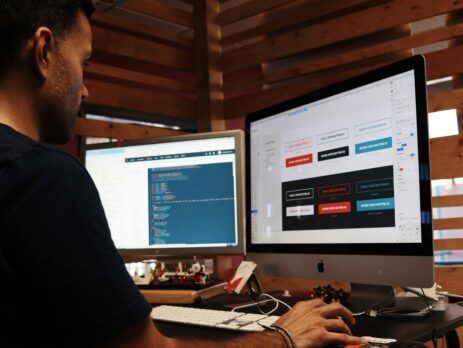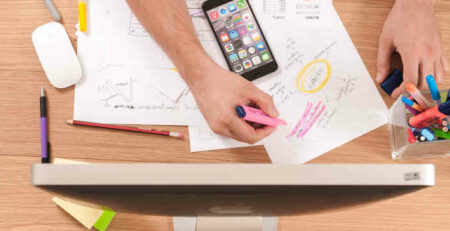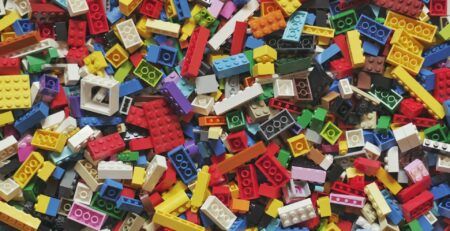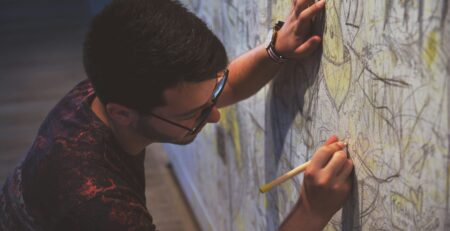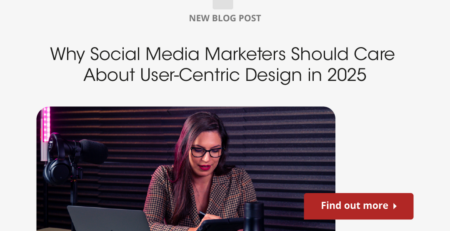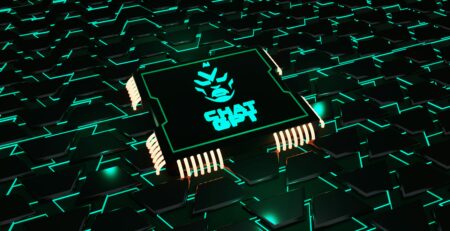Is the Flat Design Trend Finally Over? If So, What’s Next in 2024?
Design trends are generally profound because they have a way of shaping the entire ecosystem. They influence just about everything from the UI and UX of apps and websites to software being developed as well. As such, when it seems like a trend is gradually ending, being up to date, is imperative.
Now, before discussing whether the flat design trend is over and what’s coming next, a brief dive into the flat design itself.
What Is Flat Design?
Flat design is a user interface design style that incorporates basic, two-dimensional elements with eye-catching colors. Its popularity began to peak when Apple’s iOS7, Windows 8, and Google’s Material Design all used flat design. It is often placed side by side with the skeuomorphic style — which copies real-life properties to give a three-dimensional illusion.
Originally, the development of flat design was primarily targeted at enhancing responsive design whereby the device screen size didn’t impact the ability of website content to scale smoothly. Flat design was able to achieve two major goals:
- First, it ensured that responsive designs loaded fast and worked well as a result of minimal textures and simple shapes being used. In addition, the slower internet speed that is characteristic of mobile devices justified the use of this design even further.
- Second, textures and shadows were reduced, there was a drop in visual noise quantity and this ensured that user experience was more streamlined and optimal.
Now, while it did gain a great deal of popularity, there were certain drawbacks to note all in relation to user experience, which is critical to the success of any user design. Since three-dimensional effects such as drop shadows were missing, it impacted how users were able to interact with a design. This is because such effects served as cues to point users in the right direction.
A standout example is how buttons and other visual elements on a web page all appeared to be the same. Therefore, it was hard to determine that the button was indeed clickable. When this challenge was detected, a sub-trend that saw flat design applications being more balanced started — “almost flat design or flat design 2.0.”
Almost flat design involves incorporating skeuomorphic qualities like shadows and color variations into the simple and clean visuals that are characteristic of flat design. This innovation that featured increased dimension and depth saw improvement in usability and an increase in visual variety.
This subtle addition is apparent in Apple’s iOS and Google’s Material Design interfaces. Both feature shadows and effects that seem blurry to help improve user experience.
What Are the Basic Characteristics of Flat Design?
In order to accomplish the goal that flat design was originally intended for — to be highly responsive irrespective of screen sizes, it has the following basic characteristics:
- Simple shapes: flat design depicts objects by incorporating the use of two-dimensional vector art. This is as opposed to using realistic images which would be complex.
- Bright colors: these are a necessity, especially given the lack of other visual cues. The base minimalist nature of flat UI makes it such that the colors are necessary to send cues to the user.
- Basic typography: the font types in flat design are as simple as can be. A font like sans-serif typography can be read easily and it loads fast. So, flat design sacrificed intricate fonts to ensure an efficient user experience.
- Minimal textures: again, flat design eschews advanced textures such as gradients and drop shadows.
How Do UI Designers Implement Flat Design?
The vast majority of UI designers love flat design as a result of what it implies for them. Given that this design trend is heavy on user experience and less aesthetics, this implies that UI designers wield flat design as a functional tool rather than for aesthetics.
To guide users on how to navigate websites in flat design, designers use features like contrasting colors, vector illustrations, negative space, and animations. The subtle nature of flat design necessitates designers to be able to guide users through websites without excessive styling.
In addition, flat design has a grid-based layout that designers can easily use to outline an intuitive interface. Designers are more focused on passing their message and this design format aids this thanks to contrasting colors and the bold sans serif fonts. Colors are used to set the mood either by using bright colors or integrating simple neutrals to aid proper contrast.
It is safe to say that flat design prioritizes user experience. The path to smooth and flat UI is maintaining consistency and ensuring that all instructions are as clear as can be. This implies consistency in fonts, icons, and colors as well as proper hierarchical navigations and CTAs that stand out.
Pros of Flat Design
So far, flat design has been approached as a truly simplistic and modern style. While there’s a lot of truth to this, it’s imperative to note that it does help websites perform a lot better. In addition, viewing it from the UI designer’s perspective, it is also efficient and practical. It can improve the following:
- Loading time
- Readability
- SEO
- Overall user experience
Three major stakeholders benefit from flat design:
- Designers
- Users
- Search engines
Designers find creating flat websites a hassle-free operation for the following reasons:
- Can be applied to any industry
- Excellent choice for long-term designs because they are scalable and can be iterated easily
- The very nature of the design leaves them optimized for mobile and accessibility
For users, the benefit lies in the ease of reading the website content thanks to the minimalist approach. The clean fonts and white space also guarantee that website content is legible and readable. With the minimalist thing going on and simplified vectors in tow, navigation is more rapid.
SEO-wise, a simple design with the absence of comped images implies fast loading time. Users also typically stay on the website for longer because it is easy to navigate. With native fonts enhancing ease of reading, web crawlers can index a flat website without hassle.
Cons of Flat Design
Flat design does indeed boast its fair share of upsides, however, that’s not all there is to it. There can be certain downsides as well. According to the Nielsen Norman Group, following an analysis of the design during the first three years when it was peaking in popularity, there can be a user efficiency challenge.
This occurs when users can no longer decipher what is clickable and what is not as a result of the overly simplified nature of the design. This oversimplification or excessive minimalism is seen in the Microsoft Windows 8 and the 2020 redesigned Google icon. An overly flat, flat design would be lacking in cues that point out what is clickable which confuses users.
Further indications of excessive flat design could include the removal of items that users should interact with such as icons and buttons that accompany action text, the absence of colorful and underlined hyperlinks, and the removal of raised buttons.
Semi-Flat Design
The semi-flat design is basically a version of the flat design that incorporates layering and shadows. It was primarily explored because of the overly minimalistic claims that were being made about flat design. This is per reports from Norman Nielsen Group after monitoring this trend for a few years.
This resulted in a number of designers beginning to tweak their designs to make them significantly more user-friendly. The semi-flat design saw designers beginning to provide users with more direction by including features like shadows under buttons and implementing the use of animations or even arrows to point out the following steps.
The use of layers and highlights to make clickable elements more prominent happened too. This trend took off and any use of these usability features was regarded as flat design 2.0, semi-flat design, “almost flat” or “Flat 2.0.”
So, basically, a semi-flat design takes flat design and adds in some pretty practical features. Providing users with direction by including some context or depth to sections of the app or website that they want users to note.
Recall that initially, flat design wasn’t lacking in some of these things, however, as the trend went on, it became a case of trying to be as minimal as possible. So, “Flat 2.0” saw designers now incorporating some of the things that they took out prior.
So, while some elements of flat design are still being maintained, the main concept of an overly minimalist design is fading. Here are three main ways that Flat 2.0 stands out from regular flat design:
- Highlights
- Gradients
- Shadows
- Hover animations
Google’s 2014 release of Material Design saw a significant step in the “almost flat” direction. Material is a flat design system that emphasized great user experience and efficient design. Its goal is to provide a standard for app and web design.
Google’s Gmail checks the box of what a standard flat design 2.0 concept incorporates. In the most recent version, hovering over the icons sees small black captions pop up. This indicates to users that they’re clickable and also details their function.
Apple also implements flat 2.0 through gradient addition into app icons which provides the user interface with some dimension. In addition to these major players, several other websites use flat 2.0 in several ways, one of which is including shadows behind buttons.
What’s Next in 2024?
With respect to the retirement of flat design, given the new and rising popularity of Flat Design 2.0, it’s no surprise that this would be a major player in 2024. Recall that Flat 2.0 simply incorporates elements of the traditional flat design and adds in some neumorphism.
So, this concept is looking at combining flat and skeuomorphic designs using subtle gradients and shadows. This provides a measure of depth to the design, giving it a three-dimensional feel and allowing it to fit right into the trend. The key features here are/
- Highly saturated colors
- Subtle gradients and shadows
- Simple fonts
The latest leading trend which will see a lot more traction in 2024 is the move from flat design to visual styles that are more pseudo-realistic. This includes depth effects, skeuomorphism, 3D graphics, and neumorphism, among others. Several brands and companies have made 3D the center focus of their style. While this may not be apparent on app and web designs at the moment, it is definitely coming.
A basic feature that results in any trend is the fact that it has to be easy to implement. So, given that web-based 3D tools such as Vectary and Spline are allowing the process of incorporating 3D assets on apps and the web a simple one, this trend is bound to pick up momentum. These software can also inject life into 3D assets via animation, and again, it isn’t complicated to implement.
Microsoft and Apple drove the mass adoption of flat design and Airbnb is playing a role in doing that for 3D designs. 2023 saw them announce an app update with certain brand-new features. The update saw over a dozen 3D-esque visual elements. Given that they are known for their simple and highly effective app interactions and designs, they are definitely paving the way.
Features like 3D characters and animations, isometric visuals, and various app interactions later, the update was undoubtedly a major move. So, for 2024, Flat Design 2.0 might reign supreme, however, 3D is definitely coming along and would have a good deal of presence as well.
Granted that it is gradual, it would pick up pace over time. Usually, pinpointing the origin of design trends can be pretty tough, however, adoption is mainly driven by a need for realistic and relatable design. This ensures user satisfaction and provides designers with creative motivation.

Conclusion
Design trends begin and end, so, it’s only standard that while one fades out, another, or several take its place. 2024 is definitely going to see a lot of design innovations with semi-flat design taking center stage. This is going to imply a lot of interesting features for end users, and overall, significant improvements in user experience.

